Have you ever wanted to explore the unbeaten path of South Korea? Would you like to go down less-traveled routes? For visitors, driving in Korea changes everything! You may take your time seeing all the magnificent sights and hidden treasures. You may also disregard rigid tour timetables and take side trips if you come upon something interesting. One more reason to rent a car is to save money on accommodation, particularly if you intend to stay outside of the major cities.
So, if you’re ready for a South Korean road trip adventure, here’s what you should know before you hit the road!
For those who wants to watch a quick video version, watch it here:
Affiliate Disclaimer: This site contains affiliate links and I may earn commission for purchases made after clicking these links.
Driving in Korea for Tourists: the checklist
- To rent a car in South Korea, you have to be at least 21 years old. Young driver surcharges may apply from rental car companies if you are under 25.
- A valid driver’s license from your home country.
- Valid International Driving Permit (IDP) following the Geneva convention or the Vienna convention.
- You will need to present your passport for identification.
- A credit card in the driver’s name.
Singapore: Automobile Association of Singapore
United States: AAA Travel
Philippines: Automobile Association Philippines
Malaysia: Jabatan Pegangkutan Jalan
Australia: Australian Automobile Association
Indonesia: Ikatan Motor Indonesia
Japan: JAF(日本自動車連盟)
Hong Kong: GovHK
If you’re a reader from other countries, please refer to International Driving Permit website.
Choosing a Car Rental Company in korea and Booking Online
Both local and international car rental businesses operate in major cities, including major airports like Incheon and Gimpo. Whether you prefer manual or automatic transmission vehicles, you’ll discover rental options that meet your needs. To ensure availability and avoid scams, book reservations with reputable vehicle rental businesses ahead of time.
Popular cart rental companies in Korea include LOTTE Rent-a-Vehicle, SK Rent-a-Car, Hertz, Avis, and Budget. These companies offer a wide range of cars, from compact cars to luxury sedans, so you have plenty of options. Furthermore, many car rental companies in South Korea offer navigation systems with GPS and English-speaking staff to help foreign visitors.
If you plan to book a rental car online, here are some of the sites I recommend. You can book six months in advance and collect the vehicles at airports and major transportation hubs:
Selecting the Right Car
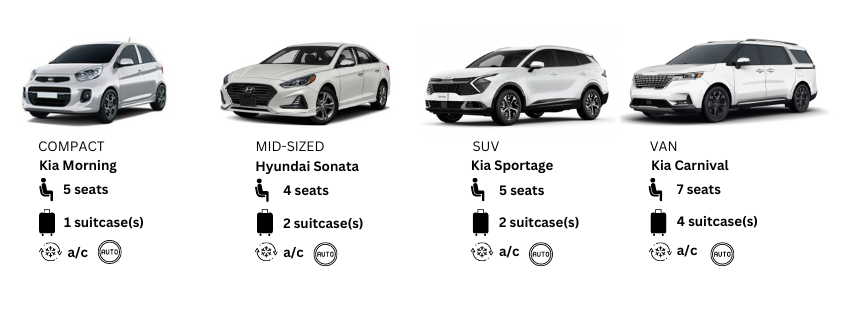
Choosing the right car depends on your planned itinerary, personal preference, and budget. For example, if you’re exploring urban areas, a compact car is perfect due to its easy navigation in traffic jams and smaller parking lots.
Typically, economy and compact cars are the most affordable to rent. They are usually more fuel-efficient, so you can save money on gas. Smaller cars are easy to navigate through narrow city streets and crowded parking lots. The Hyundai i10 and Kia Morning are popular models.
For those seeking more space and comfort, midsize and full-size cars offer advantages, especially for longer journeys or traveling with a group or family. Despite the higher rental costs and fuel consumption, midsize and full-size cars offer better safety and seating comfort. Commonly available options are the Hyundai Sonata and Kia K7.
If you need more luggage space or are planning to shop (who isn’t?!), SUVs and vans are for you. Although it is more expensive, it will provide the extra space you need. For countryside travel or a trip to Jeju Island, consider a larger vehicle for a more comfortable ride. Available options are Hyundai Staria and Kia Carnival.
Electric vehicles (EVs) offer an environmentally friendly way to explore Korea. Renting an EV provides tourists with a modern and high-tech driving experience that includes advanced features and technology, enhancing the overall driving experience. Some rental companies, like SK Rent-a-Car and LOTTE Ren-a-Car, offer promotions or free charging for EV rentals, providing cost savings for travelers. Please note that due to limitations in EV charging infrastructure in Korea, some extra planning is required, especially for driving in remote areas like the backcountry.
Planning to visit Korea? These travel essentials will help you plan your trip, get the best deals, and save you time and money before and during your Korean adventure.
Visas & K-ETA: Some travellers to Korea need a Tourist Visa, but most can travel with a Korean Electronic Travel Authorisation (K-ETA). Currently 22 Countries don’t need either one.
How To Stay Connected: Pre-order a Korean Sim Card or a WiFi Router to collect on-arrival at Incheon Airport (desks open 24-hours). Alternatively, download a Korean eSIM for you travels.
Where To Stay: For Seoul, I recommend Myeongdong (convenient), Hongdae (cool culture) or Gangnam (shopping). For Busan, Haeundae (Beach) or Seomyeon (Downtown).
Incheon Airport To Seoul: Take the Airport Express (AREX) to Seoul Station or a Limo Bus across Seoul. Book an Incheon Airport Private Transfer and relax to or from the airport.
Korean Tour Operators: Tour companies that have a big presence in Korea include Klook, Trazy, Viator, and Get Your Guide. These sites offer discounted entry tickets for top attractions.
Seoul City Passes: Visit Seoul’s top attractions for free with a Discover Seoul Pass or Go City Seoul Pass. These passes are great for families and couples visiting Seoul – you can save lots.
How To Get Around: For public transport, grab a T-Money Card. Save money on Korea’s high speed trains with a Korea Rail Pass. To see more of Korea, there are many rental car options from Klook, EconomyBookings, and RentalCars.
Travel Money: Use money exchanges near Myeongdong and Hongdae subway stations for the best exchange rates. Order a Wise Card or WOWPASS to pay by card across Korea.
Flights To Korea: I use flight comparison sites such as Expedia and Skyscanner to find the best flights to Korea from any country. Air Asia is a good option for budget flights from Asia.
Travel Insurance: It is important to insure your trips to protect yourself against the unexpected. World Nomad is a specialized travel insurance provider with options for different coverage for travellers from around the world. You can also purchase cover when you are already travelling.
How To Learn Korean: The language course from 90 Day Korean or Korean Class 101 both have well-structured lessons and lots of useful resources to help you learn Korean.
Other Add-ons
When renting a car in South Korea, there are additional add-ons to consider to enhance your rental experience and ensure a smooth journey.
Child Seat: The availability and cost of child seats vary by rental company. In South Korea, it is legally required for children under the age of 6 to be seated in a child safety seat when traveling in a car.
Car insurance for a car rental in South Korea is mandatory. The cost of a rental car typically includes insurance for personal and third-party injuries and the property of third parties.
Additional Drivers option can be added upon picking up the car from the rental location but this will incur extra charges. Each additional driver must present the same requirements as the main driver, including a driver’s license and an International Driving Permit (IDP).
Tips for renting car for driving in Korea as a tourist
Though not strictly enforced, I recommend getting a child safety seat when travelling with children. The good news is that some rental companies on Economy bookings offer child toddler seat as a free add-on in Korea. Look for this message when browsing the rentals.

Whenever you rent a car in Korea, the rental company has some insurance on the car in case something happens to the car during the rental period. The rental company will then sell you an insurance product that reduces the amount of excess you need to pay if something goes wrong. The excess amount typically goes between USD1,500 to USD2,500. The options are there, drive like a safety freak and be paranoid about any moving object near your rental vehicle, or fork out an extra ~USD15 per day for the peace of mind.
If you booked your trip with a reputable credit card that comes with complimentary travel insurance, this excess amount might be covered! Please check the terms of your travel insurance to make sure you are covered.
Lastly if you purchased travel insurance for your trip, this excess amount might be covered as well. Having travel insurance has many benefits, and I always recommend getting one when travelling. Once again please check the terms before making the decision of forgoing insurance for your rental vehicle.
Ask any questions you may have. Check all terms and conditions, including insurance, mileage, fuel, and any fees. Before leaving, do a visual inspection to see if there is any damage that has already occurred. Make a note of any visible damage by taking a photo or video and documenting it as evidence, so you don’t have to pay any extra when existing damages are found.
Useful Navigation Apps for driving in Korea
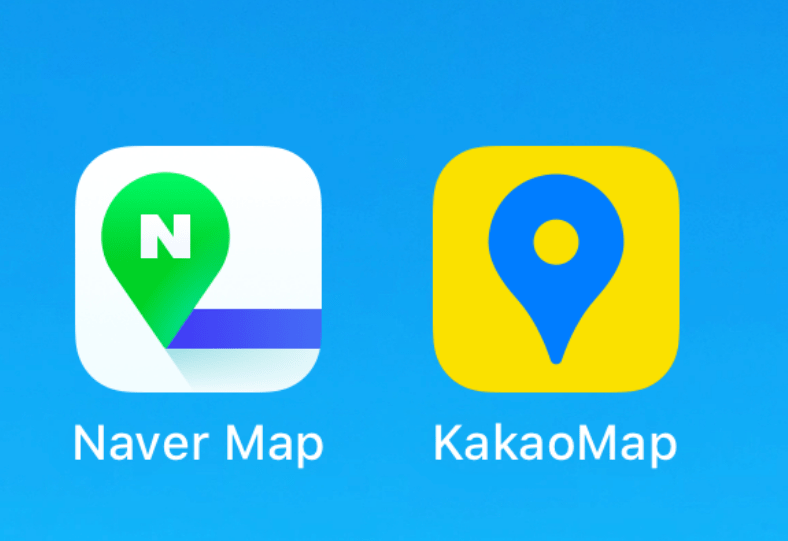
Naver Map (neibeo jido) is one of the most popular mapping and navigation apps in South Korea, providing accurate directions, real-time traffic information, and a variety of features like SmartAround for detailed information on locations, reviews, and menus of famous restaurants or shops.
KakaoMap (kakaomaeb) is another widely used map app in Korea, known for its high accuracy and convenience. It offers features like linking to KakaoTalk and KakaoTaxi, providing directions for various modes of transport, and voice reports for congestion and speed cameras.
Google Map is one that I keep trying to use (with disappointment), as I have had great experience using it in countries like Japan and Australia. But I don’t recommend it at all for driving in Korea, as the navigation is often inaccurate and the above 2 are just better in every way in Korea.
Most car rental companies also offer GPS devices with the rental, but I personally prefer navigating with a phone when driving in Korea, as the data is more updated and the touchscreen just feels better than most GPS devices.
To navigate with phone apps, make sure you have enough mobile data on your phone. Getting a Korean sim or esim plan will be essential. I suggest allocating at least 300MB of data per day for navigation on a typical day of driving. If you are using Naver Map, I also recommend downloading offline-ready maps specifically for the areas you plan to visit; this will save you precious mobile data and help navigate through cellular dead zones. Additionally, remember to bring a charging cable or power bank to ensure your phone stays charged for navigation.
Fueling up
Fueling up can be daunting if you’re not sure what to expect. I remember my first time fueling up at a self-service fuel station, and knowing little Korean at that time, it was tricky.
It is crucial to always return a rental car with a full tank; failing to do so can result in additional charges. In South Korea, car rental fuel policies usually follow the ‘full-full’ principle, requiring you to return the rental car with the same amount of fuel it had when you received it. As the driver, you are accountable for the fuel consumed throughout the rental period. The rental company determines the fuel usage by comparing the initial and final fuel levels of the vehicle.
Step-by-step guide for fueling up at a korean self-service station
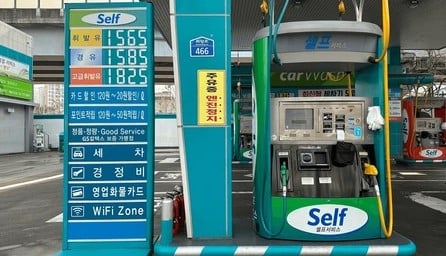
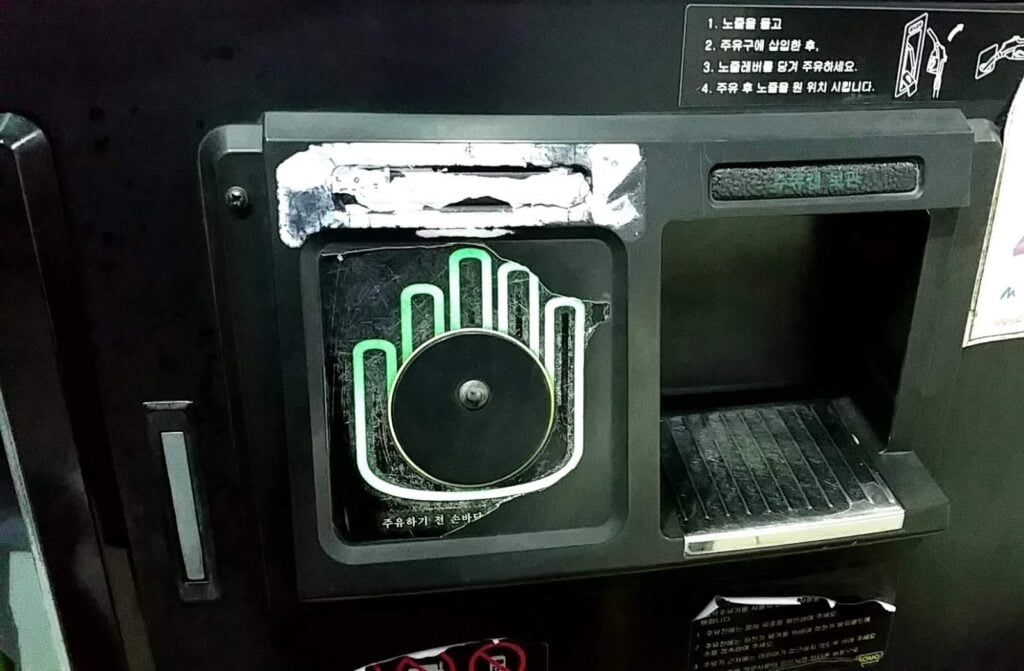
- Identify the Fuel Type
- Gasoline stations are marked with the Korean word “주유소” (pronounced “joo-you-so”), while LPG stations are marked as “LPG충전소” (pronounced “LPG choong-juhn-so”)
- Gasoline pumps are typically yellow, while diesel pumps are green.
- Activate the Pump
- Locate the anti-static pad on the pump and touch it to reduce the risk of static electricity buildup.
- Press the “시작하기” (“Start”) button to begin the fueling process.
- Select the Fuel Type
- Choose the appropriate fuel type, either gasoline (“휘발유”) or diesel (“경유”), based on your vehicle’s requirements
- Pump the Fuel
- Payment
- You can pay for the fuel using cash, credit/debit cards, or the Hi-Pass electronic toll payment system. If using a card, insert it into the card reader on the pump and follow the on-screen prompts to complete the transaction.
- Refueling Completion
- Once the tank is full, the pump will automatically stop, and you can replace the fuel nozzle. Ensure you have properly replaced the fuel nozzle and close your vehicle’s fuel tank cover before driving away.
Cost of petrol
The cost of petrol in South Korea fluctuates according to the international oil price, with prices reported at around ₩1,673 per liter, or approximately USD 1.27 per liter, as of April 2025. Check here for recent prices.
Road and Traffic Rules in South Korea
In South Korea, traffic operates on the right-hand side of the road, so drivers should keep to this lane. Wear your seat belt at all times while driving, as safety is a top priority. Additionally, using mobile phones while driving is strictly prohibited unless they are operated in a hands-free manner to minimize distractions. Do not drink and drive in Korea! The legal blood alcohol concentration (BAC) limit of 0.03% and refrain from drinking and driving to ensure the safety of yourself and others on the road.
Speed Limits
Like many other countries, South Korea imposes the maximum allowed speed limit on all roads.
- Highways: Speed limits vary between 100-120 km/hr.
- Open roads: The speed limit is normally 80 km/hr.
- City roads: Speed limits not more than 60 km/hr, depending on the specific area and road conditions.
Some common road signs and symbols, along with parking regulations in South Korea:
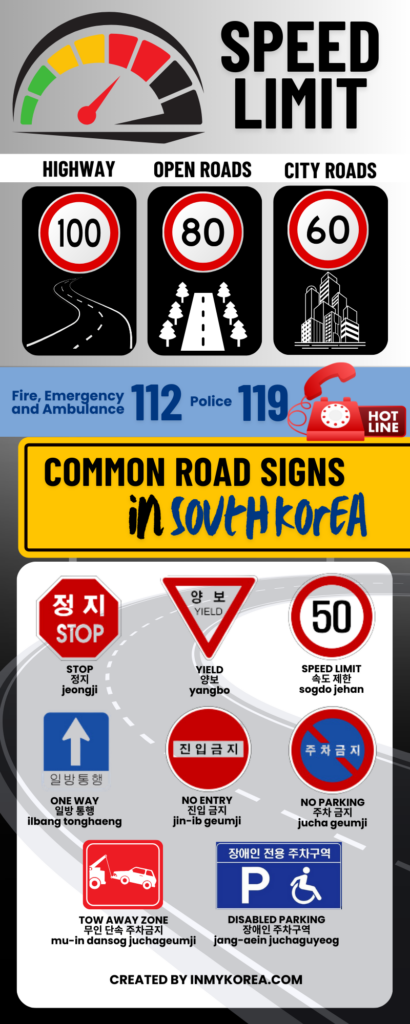
- Stop Sign (정지/): A red octagonal sign with “정지” written in white. Drivers must come to a complete stop and yield the right-of-way to vehicles and pedestrians.
- Yield Sign (양보): A downward-pointing triangle with a red border and “양보” written in white. Drivers must yield the right-of-way to vehicles on the intersecting road.
- Speed Limit Signs (속도 제한): Circular signs with the maximum speed limit displayed in kilometers per hour (km/h). Common speed limits are 60 km/h in urban areas and 80-100 km/h on highways, but they may vary.
- No Entry Sign (진입 금지): A red circle with a white horizontal bar across it and “진입 금지” written underneath. Indicates that entry into a certain area or road is prohibited.
- One-Way Sign (일방 통행): A rectangular sign with an arrow indicating the direction of traffic flow and “일방 통행” written underneath. Indicates that traffic is allowed to flow in only one direction on the specified road.
- Parking Sign (주차 허용/금지): Signs indicating whether parking is allowed or prohibited. “주차 허용” means parking is allowed, while “주차 금지” means parking is prohibited.
- Disabled Parking Sign (장애인 주차구역): Indicates designated parking spots for disabled individuals. Parking here without proper authorization can result in fines.
- Loading/Unloading Zone Sign (화물 로딩/로딩 구역): Indicates areas where loading and unloading of goods are permitted. Typically found near commercial areas.
- No Parking Sign (주차 금지): A red circle with a white horizontal bar across it and “주차 금지” written underneath. Parking is prohibited in the specified area.
- Tow Away Zone Sign (무인 단속 주차금지): Indicates areas where vehicles parked illegally may be towed away by authorities
Turning Left on a Green Light in South Korea

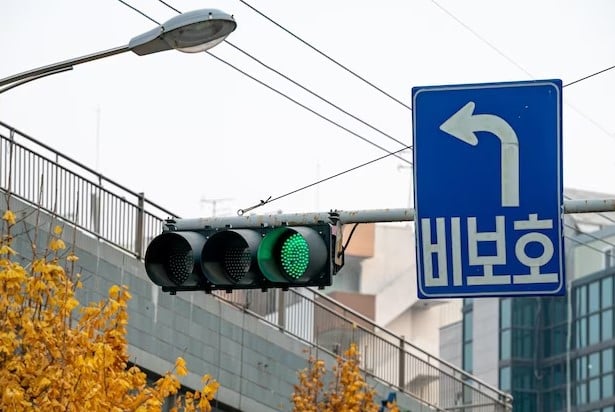
In South Korea, the general rule is that drivers are not allowed to turn left on green lights at intersections unless there is a specific green arrow signal indicating that left turns are permitted.
When there are four signal lights at an intersection, drivers will typically need to wait for a green arrow to appear before making a left turn, as the green light alone does not authorize left turns in most cases.
However, there is an exception to this rule when drivers see a blue sign that says “비보호” with a left arrow on it. In this case, drivers can turn left on the green signal without waiting for a green arrow.
Turning Right
Similar to the US, you are allowed to turn right on red.
Use of Hazard Lights
The use of hazard lights (or emergency lights) in South Korea has several distinct meanings beyond standard emergency signaling.
- Indicating a search for a parking spot
- Expressing gratitude or apology, “thank you or “sorry”
- They are alerting others to a hazard or obstruction
- Indicating a stopped or parked vehicle
Tolls in South Korea

Tolls in South Korea are calculated based on several criteria, including the distance traveled, the type of roads used, and the type of vehicle. Tourists can pay tolls in cash, credit card, or T-Money Card and hi-pass cards at toll booths on the expressways.
Here are the guidelines for toll payments. Here’s what you need to know:
- Ticket Collection: Upon entering a toll booth at your departure location, make sure to collect a ticket from the toll booth attendant. This ticket will indicate the entry to the highway.
- Payment at Destination: When you reach your destination and encounter another toll booth, present the ticket you received at the departure toll booth to the attendant and pay the toll fee accordingly.
- No Hi-Pass System: Rental cars in South Korea normally are not equipped with the Hi-Pass automated toll payment system.
- Avoid Blue-Marked Lanes: Do not drive through lanes marked with blue symbols, as these are designated for vehicles equipped with the Hi-Pass system. Using these lanes without the system may cause complications and delays.

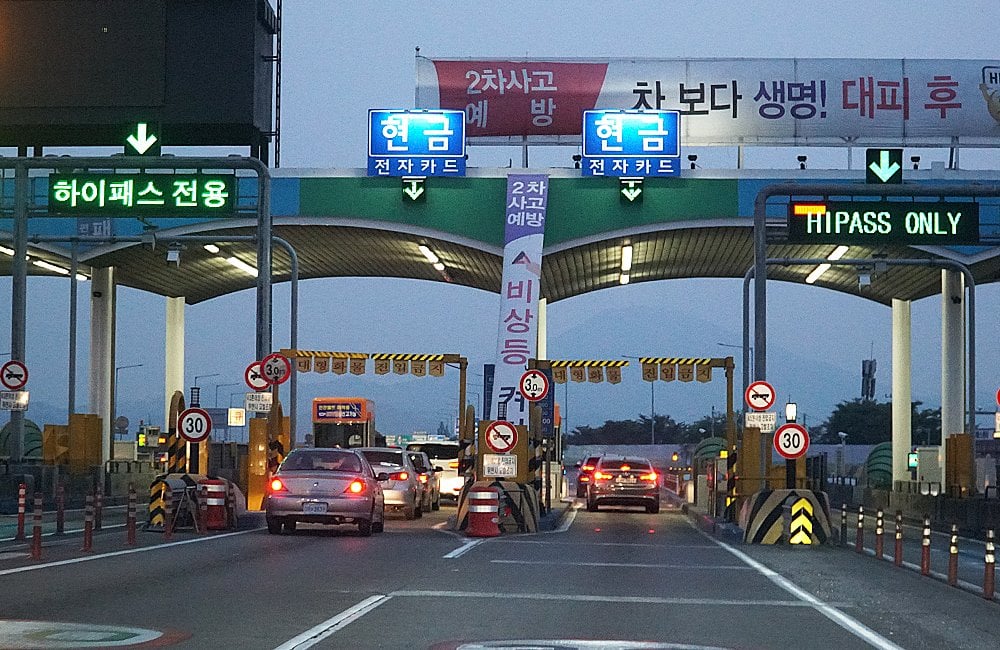
Tips: Avoid the left-most lanes marked in blue unless you have a hi-pass. Instead, use the cash lane (현금 means cash), commonly located to the right, which also accepts T-money cards. Note that credit cards may not be accepted unless they are Korean credit cards, so it’s safer to carry some cash.
Parking in South Korea
Parking costs in Seoul can vary depending on location and time of day. On average, parking costs range from 1,000 to 4,000 KRW per hour.
Public parking lots typically offer more affordable rates compared to private parking lots. They often provide a 50% discount for “light cars,” which are small and eco-friendly vehicles. Some parking zones implement a “first two hours free” policy, making them convenient for quick stops or visits to nearby stores.
If you park at public or private parking lots, you’ll encounter signs near the entrance or at the worker’s booth displaying the applicable rates. Some lots utilize automated systems that scan your license plate and calculate the parking fee automatically upon exit.
Street parking is not allowed unless the parking spot is marked with a white line. If the parking spot has numbers or signs on it, then it is a residential parking spot.
Double Parking
Don’t be surprised! Parking in residential areas is quite challenging. Double parking in residential areas is normal due to the lack of space. Most Korean cars display their phone number on their windshields so they can be reached if their car is blocking someone in parking lots.
Advanced Parking System
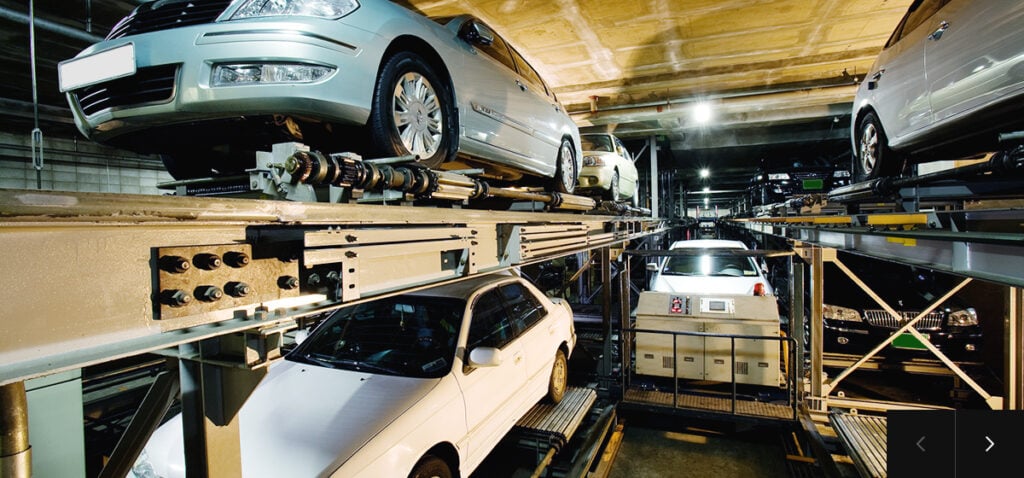
Shopping centers, hotels, and multiplex cinemas in city areas often offer automated car parks that incorporate conveyor-type systems to prioritize user safety and convenience. Drivers can drive into a platform within a garage of single-car size, exit the vehicle, and have it automatically parked like a car vending machine.
Tips: When booking accommodation, look for ones that explicitly mention parking availability in their descriptions or amenities list. Having parking available at your hotel can save you time and hassle.
The alternative: Public transport and taxis in Korea
If your itinerary consists mainly of the main cities like Seoul and Busan, I recommend taking public transport instead. Public transport is generally the more convenient and comfortable option for tourists in South Korea. After factoring expenses like fuel, tolls, parking fees, and insurance, or if a short budget is a constraint, still taking a bus, subway or taxi is often more cost-effective and practical than renting a car.
Subway: Seoul
The Seoul subway system is one of the most efficient ways to travel around the city. Trains run non-stop from approximately 5:30 am until midnight. All subway lines are color-coded and stations display signs in Korean, English, and Chinese. To ride the subway, you must use a single or multiple journey pass. Single-journey passes can be purchased in the subway stations and require exact fare to your destination plus a 500-won refundable deposit.
Multiple journey passes called T-money can be purchased at most convenience stores. Transfers between subway lines are free, and T-Money Card users can transfer for free between bus and subway lines. Smartphone and tablet users can download a variety of apps that give routes, times, and transfer information in English, including Seoul Subway, Metroid Korea Subway Info, and Subway Navigation by Kakao.
Bus
Riding a bus as a tourist is another convenient way to explore the cities of South Korea. Bus routes reach places that may not be accessible by other modes of transport, like subways.
Tourists can easily check bus routes or map apps, and digital bus stops in city centers provide real-time information on bus locations for travel convenience. Tap the T-Money Card to the card reader when you enter the bus to start your journey, then tap it again when you exit the bus. In most city buses in Korea, you enter at the front of the bus and get off in the middle. There will be a T-Money Card reader in both locations.
Taxi
In South Korea, taxis offer wide options based on your needs including regular and deluxe standard taxis, as well as international taxis with multi-lingual drivers for travelers’ convenience. Fares vary by city and taxi type, usually a base fare and additional charges based on distance traveled, with late-night surcharges applicable during specific hours.
The best way to get a taxi in Korea is with a taxi booking app, such as Kakao Taxi. This will allow you to call a taxi directly to your location and to set the final destination. This allows you to book taxis without speaking Korean and also shows you the expected cost of the journey. If you’re arriving at a train or bus terminal, there are usually taxi ranks outside where you can get a taxi any time of the day.
Driving in Korea as a tourist FAQs
Is South Korea a left or right-hand drive country?
South Korea is a right-hand drive country, where vehicles drive on the right side of the road.
Is it safe to drive in South Korea?
Yes, driving in South Korea is considered safe, thanks to its well-kept road infrastructure and comparatively low incidence of traffic-related fatalities.
Is driving in Korea difficult?
Driving in Seoul can be challenging due to factors like traffic congestion, navigational difficulties, and language barriers. However, it is relatively safe and manageable, especially outside of the major cities.
Can tourists drive in Korea?
Yes, they can as long as they have a valid International Driving Permit (IDP) in addition to their local driver’s license.
What type of car can I rent in South Korea?
The IDP you hold will determine the size of the car you can rent in South Korea. Grade B permits renting vehicles up to 9 seaters, while Grade D permits renting vehicles with up to 12 seats. Car rental options vary from compact cars to SUVs and Vans. Some rental companies offer specialty vehicles like hybrid or EV cars.
Are gas stations in South Korea self-service or full-service?
In South Korea, the majority of gas stations especially in larger cities like Daejeon, Busan, Ulsan, Incheon, and Seoul have transitioned towards self-service, with only a small percentage remaining as full-service stations.
What are the emergency telephone numbers in South Korea?
In case of emergencies, you can contact the police at 112 while 119 for fire service and ambulance services.
Is it worth renting a car and driving Korea as a tourist?
It depends! Renting a car and driving in South Korea can be a good option for tourists with young children and rural destinations on their itinerary.
Good choice to rent a car:
You plan to visit mostly rural areas with limited public transportation options
Having the flexibility to stop and go as you please is important for you, especially with young child(ren)
You’re comfortable driving in a foreign country
Better to skip the car:
Your itinerary focuses on major cities like Seoul or Busan
You’re not comfortable driving in a foreign country, especially with unfamiliar signage
You’re on a tight budget
Liked This? Pin It For Others
If you enjoyed reading this article, then please share this with your friends on Pinterest.
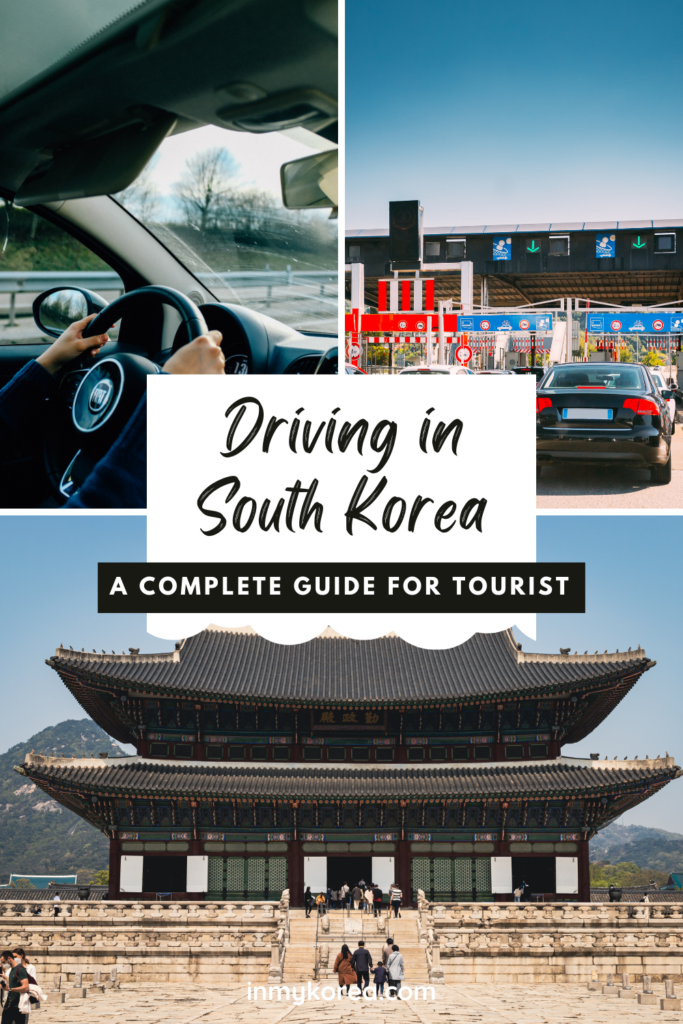

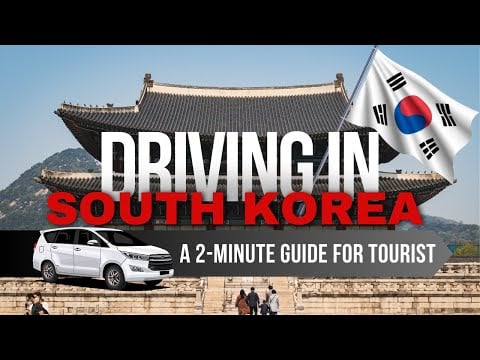




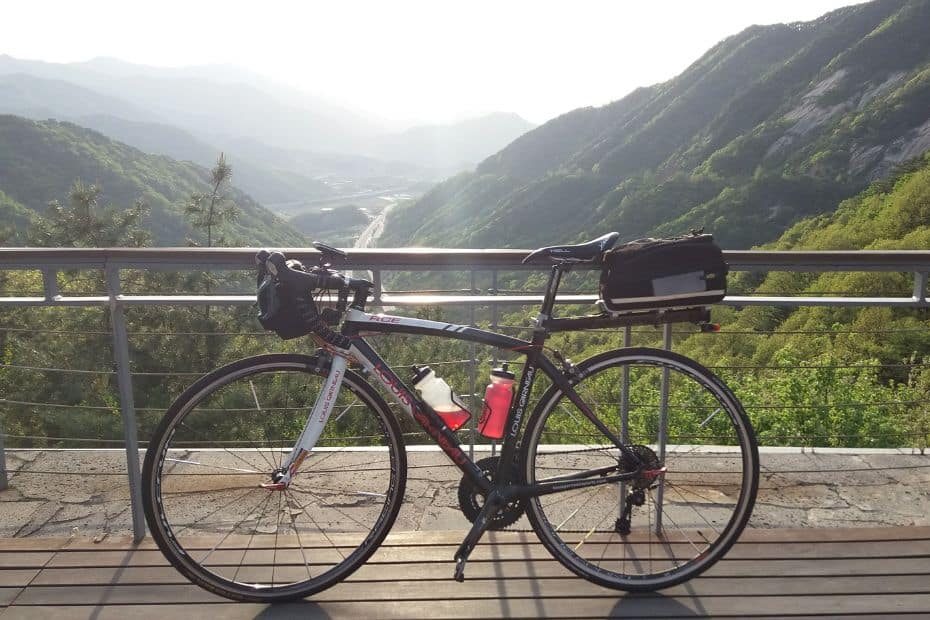

Driving around with a toddler is definitely a game-changer! Just having time for the child to rest in the car when needed is worth getting the car. Thanks for this guide for driving in Korea, I’m flying to Incheon airport next month, will be looking to rent a car from there, which companies do you recommend from there?
Yes, having your children when travelling is challenging if you must take public transport all the time. There are many car rental companies that service the Incheon airport area. Please see these links, all of them offer plenty of options from Incheon Airport that you can compare and book from:
I’m coming from a left-hand drive country (UK), do you think it is possible for me to drive in Korea in my next trip?
It will take some getting used to, I’ve driven in Korea myself, and it really took me about 2 days on the road to feel comfortable. I think take some extra time in the beginning to get used to the rules, and the different driving side, and you should be good to go.
Drive safe and enjoy Korea!